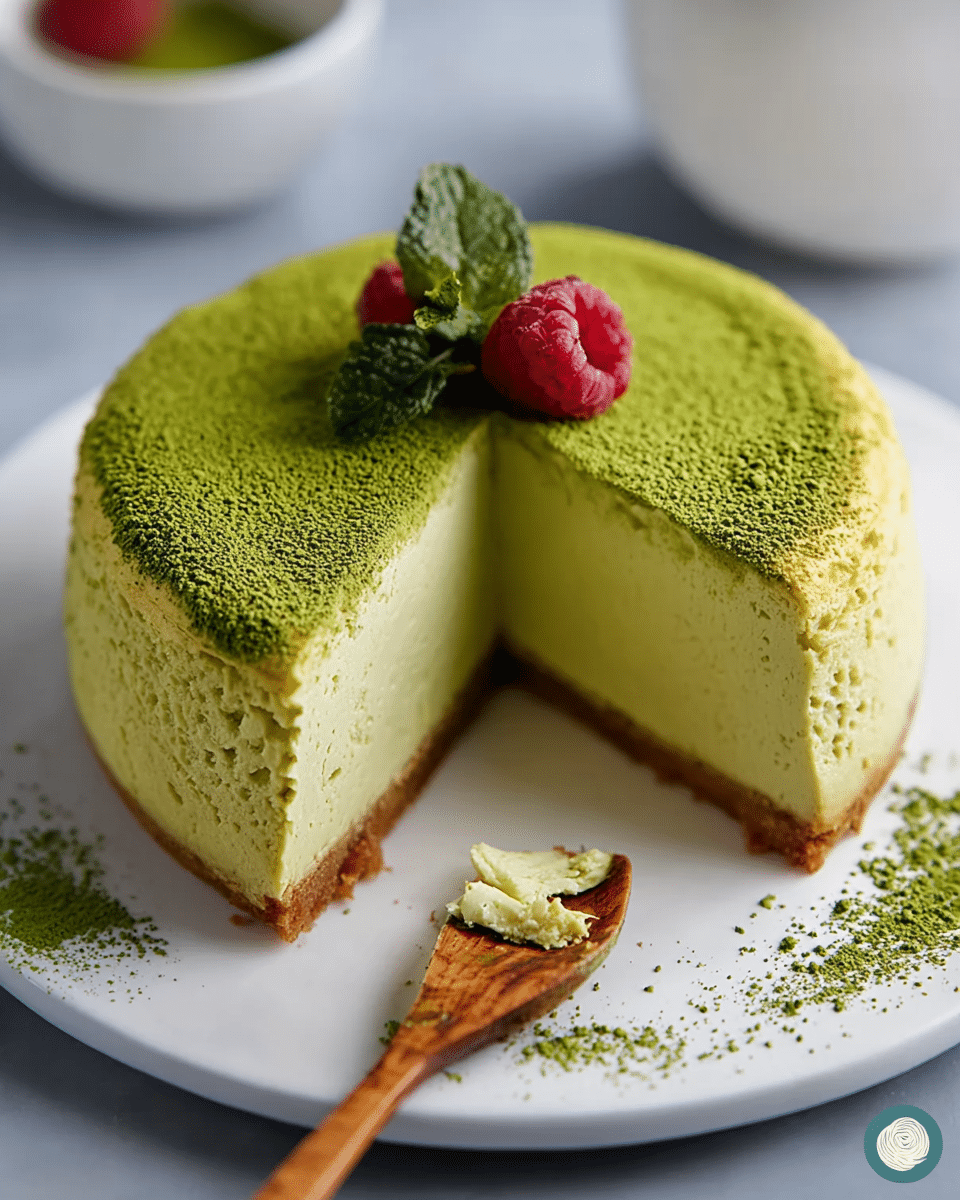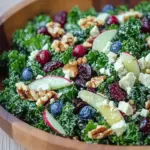This Original Matcha Japanese Cheesecake is the perfect blend of creamy cheesecake and earthy matcha, bringing together the best of both worlds. Inspired by the light, airy texture of traditional Japanese cheesecakes, this dessert offers a refreshing twist with the vibrant green matcha flavor. The result is a soft, fluffy cheesecake that melts in your mouth, leaving a subtle, delightful matcha aftertaste. It’s a must-try for anyone who enjoys both cheesecake and matcha!
Full Recipe:
Ingredients
For the Batter:
-
1 cup (225 g) cream cheese
-
1/4 cup (55 g) butter
-
5 egg yolks
-
1/4 cup (50 g) granulated sugar
-
1/4 cup (30 g) cake flour
-
2 tablespoons (about 16 g) cornstarch
-
1/2 teaspoon baking powder
-
1 teaspoon vanilla extract
-
1 teaspoon lemon or yuzu juice
-
1/2 cup (120 g) milk
-
1 to 2 teaspoons culinary matcha
For the Stiff Peaks Meringue:
-
5 egg whites (room temperature)
-
1/2 teaspoon cream of tartar
-
1/4 cup (50 g) granulated sugar
For the Toppings:
-
1 tablespoon confectioners’ sugar (optional)
-
Matcha for dusting the top of the cake
-
Optional fruits (e.g., strawberries, blueberries)
Directions
-
Make the Batter: In a pot over low heat, combine cream cheese and butter until smooth and creamy. Remove from heat and whisk in sugar, egg yolks, cake flour, cornstarch, baking powder, vanilla, lemon juice, matcha, and milk. Whisk until fully incorporated and smooth. Set aside.
-
Prepare the Meringue: In a separate bowl, beat the egg whites until frothy. Gradually add cream of tartar and sugar while continuing to beat until stiff peaks form.
-
Combine Batter and Meringue: Gently fold a portion of the meringue into the matcha batter to lighten it. Gradually fold in the rest of the meringue until fully combined.
-
Bake the Cheesecake: Pour the batter into a prepared pan. Tap the pan to release air bubbles. Place the pan in a larger baking dish, and add hot water around the cheesecake pan. Bake at 320°F (160°C) for 18 minutes, then reduce the temperature to 285°F (140°C) and bake for an additional 50–60 minutes until golden.
-
Cool the Cake: Turn off the oven and leave the door slightly ajar for 20 minutes. Remove the cheesecake, and flip it onto a plate to remove parchment paper. Flip it again onto a serving plate.
-
Garnish and Serve: Dust with powdered sugar and matcha. Garnish with fresh fruits if desired. Serve warm or refrigerate for a firmer texture.
Nutrients
-
Serving Size: 1 slice
-
Calories: 230 kcal
-
Carbohydrates: 25g
-
Protein: 6g
-
Fat: 14g
-
Saturated Fat: 8g
-
Sugar: 10g
-
Cholesterol: 95mg
-
Sodium: 140mg
The Magic of Matcha
Matcha, a finely ground powder made from specially grown green tea leaves, is known for its unique flavor profile. Unlike regular green tea, where the leaves are steeped and discarded, matcha is consumed whole, which allows it to retain all the nutrients and flavors of the leaves. Matcha brings a slightly bitter, earthy flavor to the cheesecake, which is balanced by the sweetness of the batter and the richness of the cream cheese. This combination creates a unique flavor profile that is both refreshing and indulgent, making matcha a popular ingredient in various desserts. In addition to its flavor, matcha is packed with antioxidants, particularly catechins, which are known for their health benefits. Adding matcha to the Japanese cheesecake not only enhances the taste but also makes the dessert a bit healthier than traditional cakes.
The Light and Airy Texture of Japanese Cheesecake
Japanese cheesecakes are known for their delicate, light, and airy texture, which sets them apart from traditional American cheesecakes. The secret to this texture lies in the meringue and the careful folding technique that incorporates air into the batter. The meringue is made by beating egg whites until stiff peaks form, and then gently folding them into the cream cheese batter. This technique ensures that the cheesecake will rise during baking, creating a fluffy, almost souffle-like texture that is both soft and light. The result is a cheesecake that feels less heavy than its American counterpart, with a cloud-like texture that melts in your mouth. This makes it the perfect dessert for those who enjoy cheesecake but prefer something lighter and less dense.
The Role of Cream Cheese and Butter
In any cheesecake, cream cheese is the key ingredient that provides the rich, creamy base. In the Original Matcha Japanese Cheesecake, the cream cheese is paired with butter, which adds extra richness and smoothness to the batter. The cream cheese and butter mixture is gently heated to create a smooth, velvety base before the rest of the ingredients are added. The richness of the cream cheese balances out the earthy bitterness of the matcha, while the butter ensures the cake remains creamy and moist, even after baking. Together, these ingredients create a luxurious foundation for the cheesecake that supports the delicate texture and enhances the overall flavor.
The Importance of Egg Yolks and Meringue
Egg yolks play an essential role in creating the rich, smooth texture of the cheesecake batter. They help to emulsify the ingredients, ensuring that the cream cheese, butter, and matcha blend together seamlessly. Egg yolks also contribute to the cake’s richness, creating a custard-like texture that melts in your mouth. Meanwhile, the meringue, made from egg whites, is crucial for giving the cheesecake its airy, light texture. By beating the egg whites with sugar and cream of tartar until stiff peaks form, the meringue traps air in the batter, causing the cake to rise and giving it that fluffy, soufflé-like texture. The gentle folding of the meringue into the batter is what creates the signature lightness of Japanese cheesecakes, making them stand out from more dense, traditional cheesecakes.
Baking the Perfect Japanese Cheesecake
Baking the Original Matcha Japanese Cheesecake requires precision and patience. The cake is baked using a water bath method, where the cheesecake pan is placed in a larger pan filled with hot water. This technique ensures that the cake bakes evenly, preventing it from cracking or drying out. The gradual baking at a low temperature helps the cheesecake set slowly, preserving its delicate texture. The key to a successful Japanese cheesecake is not to overbake it; the cake should still be slightly jiggly in the center when you remove it from the oven. After baking, the cheesecake is allowed to cool gradually in the oven with the door slightly ajar, which helps to prevent sudden temperature changes that could cause the cake to collapse or crack.
The Role of Lemon or Yuzu Juice
Lemon juice or yuzu juice is added to the batter to provide a touch of acidity, which helps to balance the richness of the cream cheese and butter. The acidity also enhances the matcha flavor, giving the cheesecake a bright, refreshing undertone. While lemon juice is commonly used in many cheesecake recipes, yuzu juice—an aromatic citrus fruit native to Japan—adds a unique, fragrant quality to the cake. Yuzu has a flavor profile that’s similar to lemon but with floral, slightly tangy notes, making it a perfect complement to the matcha. This subtle citrusy element enhances the overall flavor of the cheesecake, adding complexity and depth without overpowering the matcha or the creamy texture of the cake.
Toppings and Presentation
One of the best aspects of the Original Matcha Japanese Cheesecake is how easily it can be garnished to suit different occasions. While the cake is delicious on its own, it can be elevated with a simple dusting of powdered sugar and matcha, which adds a pop of color and a touch of extra matcha flavor on top. For a more indulgent presentation, you can add fresh fruits like strawberries or blueberries, which provide a contrast to the rich creaminess of the cheesecake. The slight tartness of the fruit pairs wonderfully with the sweetness and bitterness of the matcha, creating a balanced flavor profile. The contrast of colors between the green matcha, the pale yellow of the cheesecake, and the bright fruit makes for an elegant and visually appealing dessert that’s perfect for special occasions.
Serving Suggestions
The Original Matcha Japanese Cheesecake is best served slightly chilled or at room temperature. It can be enjoyed on its own or with a cup of tea, making it an ideal dessert for a cozy afternoon or a dinner party. The light, airy texture of the cheesecake makes it a great dessert after a heavy meal, as it won’t feel overly filling. The matcha flavor also pairs wonderfully with a variety of drinks, including green tea, matcha lattes, or even a glass of chilled white wine. Whether you’re serving it as a light dessert at the end of a meal or as a treat with friends and family, this cheesecake is sure to impress with its beautiful presentation and delicate, balanced flavors.
Conclusion
In conclusion, the Original Matcha Japanese Cheesecake is a unique and sophisticated dessert that combines the creamy richness of traditional cheesecake with the earthy, vibrant flavor of matcha. Its light, airy texture and delicate flavor make it a standout dessert that is both indulgent and refreshing. The cheesecake’s mild sweetness, combined with the subtle bitterness of matcha and the citrusy notes of lemon or yuzu, creates a harmonious balance that appeals to a wide range of tastes. Whether you’re a fan of matcha or simply looking to try something new, this cheesecake is a must-try treat that offers a perfect blend of flavors. Its versatility in presentation, ease of preparation, and elegant taste make it a delightful dessert for any occasion.






